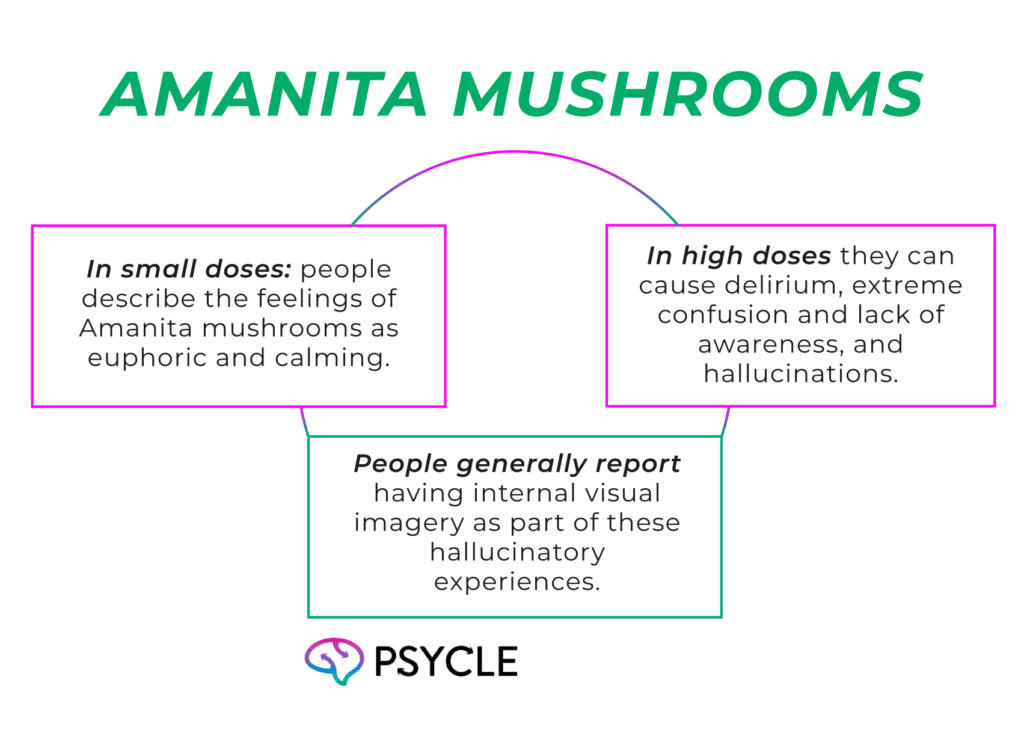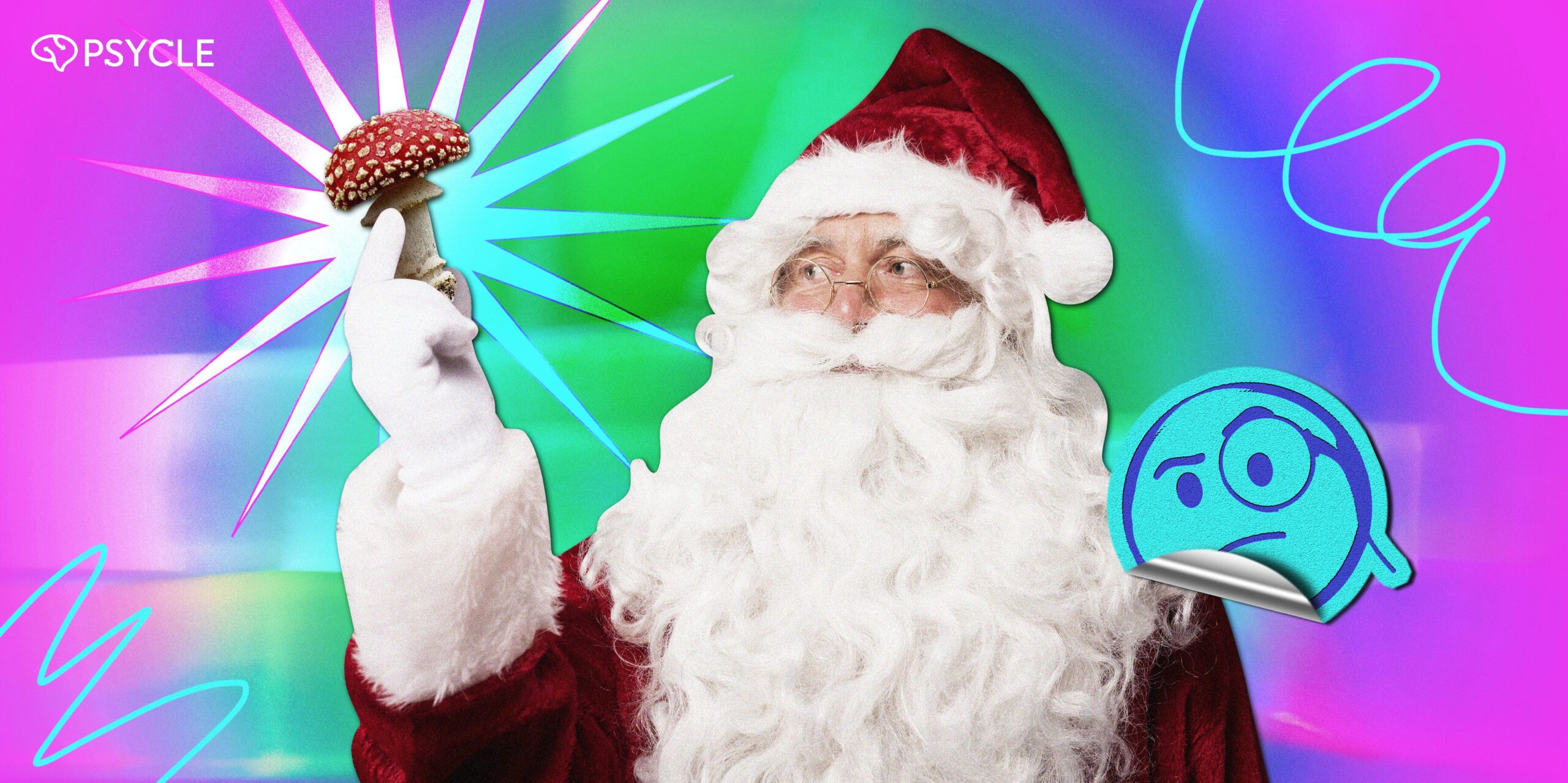Amanita muscaria, or fly agaric, is the iconic red-and-white mushroom that seems straight out of a fairytale. While it’s long been associated with folklore, people are now questioning whether it could explain the origins of Christmas.
In this article, we’ll look into these mushrooms and see how valid this theory really is.
Key Takeaways
- Amanita muscaria is a psychoactive mushroom that works differently from psilocybin mushrooms.
- The mushroom contains two main compounds: ibotenic acid, which can be toxic in high doses, and muscimol, which causes relaxation.
- Siberian shamans may have used Amanita muscaria in rituals to enter trance states and seek guidance from the spirit world.
- Some theories associate Amanita muscaria with Santa Claus imagery, including the red-and-white colors, flying reindeer, and stockings.
- There’s little evidence to support the Amanita Christmas theory, and Santa’s modern image is more likely shaped by other influences.
What is Amanita Muscaria?
Amanita muscaria, also known as fly agaric, resembles something out of a fairytale. It’s the image that will probably come to your mind if asked to think about a toadstool mushroom: a bright red cap dotted with white spots and a thick white stem underneath. It plays a strong role in folklore, often appearing in pictures and stories about fairies, trolls, and other mythical creatures.
The species grows all across the Northern Hemisphere, in Europe, Russia, parts of North America, and Asia. It tends to grow near birch, pine, and spruce trees, forming partnerships with their roots, which helps them absorb water and nutrients.
When people talk about magic mushrooms, they’re generally referring to mushrooms that contain the chemical compound psilocybin, such as Psilocybe cubensis or Psilocybe semilanceata. Amanita species are psychoactive, but they work through different mechanisms and don’t have typical psychedelic effects.
Is Amanita Muscaria Psychedelic?

The two best-known chemicals in Amanita mushrooms are ibotenic acid and muscimol. Ibotenic acid affects glutamate receptors, which play a crucial role in sending signals between brain cells, changing normal perception, and inducing hallucinations. Muscimol, on the other hand, activates GABA receptors, similar to alcohol, which causes relaxation.
In small doses, people describe the feelings of Amanita mushrooms as euphoric and calming. However, in high doses, they can cause delirium, extreme confusion and lack of awareness, and hallucinations. People generally report having internal visual imagery as part of these hallucinatory experiences.
In general, the effects of Amanita mushrooms are less predictable than those of psilocybin mushrooms. They also carry greater risks, since ibotenic acid can be poisonous in high amounts.
Amanita Muscaria in Shamanic Traditions
Shamans in Siberia may have long used Amanita muscaria to enter trance states and communicate with spirits, taking advantage of their psychoactive effects. This practice has been associated with the Sami people, an indigenous group residing in northern Norway, Sweden, Finland, and Russia.
The Sami are one of Europe’s oldest indigenous cultures, following an animistic tradition that believes all natural things, animals, plants, and fungi, possess a spirit or soul. Traditionally, a Sami shaman, known as a Noaidi, was responsible for healing and guidance, using the ability to enter other realms to gain knowledge and help their community.
The Story of Amanita Muscaria and Christmas
People have suggested that Santa Claus or elements of the modern Christmas figure are related to the shamanic use of Amanita muscaria. They believe that Santa’s red and white outfit may be based on the appearance of these mushrooms.
According to such theories, shamans would guide rituals with Amanita muscaria, in which they’d experience visionary flights towards the North Star, like Santa flying on his sleigh. They would deliver sacred knowledge to the community, which would be like Santa bearing gifts.
To make the mushrooms less toxic, shamans supposedly dried them over a fire in a sock, which could explain the images of Christmas stockings. Other theories state that shamans relied on reindeer, which can eat Amanita muscaria, to process the mushrooms.
Allegedly, shamans would drink reindeer urine, as it could contain the active compounds, but with lower levels of ibotenic acid. This practice may have inspired the image of magical flying reindeer.
Problems with the Amanita–Santa Theory
The idea that Santa comes from Amanita muscaria is a fun theory, but there isn’t much solid evidence for it. You’ll see it in lots of popular articles, but not in any scholarly research.
In fact, when it comes to European shamanistic practices, we still don’t know much about their rituals and use of psychoactive substances. Many of these traditions relied on oral knowledge, and so there are limited written records.
There are also significant limitations to this theory. A major caveat is that the Santa figure developed in Western Europe and North America, rather than in areas where shamanic use of Amanita muscaria has been documented. The use of Amanita muscaria in these regions is also unclear.
Additionally, since the effects of the mushrooms are so varied, Amanita muscaria doesn’t necessarily seem like a reliable shamanic tool.
Other Stories Behind the Origins of Santa Claus
Other legends of Santa’s origins are more widely accepted than the Amanita theory.
For instance, one major origin story comes from Saint Nicholas, a Christian bishop from the 4th century in Myra (modern-day Turkey). Nicholas was known for his generosity and care for children. Apparently, he would give gifts to those in need at night, and one story includes him placing gold coins in the stockings of young women.
Legends of gods and magical animals in Norse mythology may have also influenced the Santa Claus story. For example, myths of the Norse god Odin riding through the sky on a flying horse resemble the image of Santa in flight.
Santa’s red-and-white coat is likely a more recent addition, as early depictions of Santa often show him wearing green. The now-famous red-and-white outfit is thought to have been popularized by a Coca-Cola marketing campaign, rather than having any connection to mushrooms.
FAQs
Are Normal Magic Mushrooms Used in Shamanism?
Yes. Psilocybin-containing mushrooms (often called “magic mushrooms”) have been used in shamanic and spiritual practices. Their use is more documented in Mesoamerican traditions, particularly among Indigenous groups in Mexico, compared to in Europe. However, there may have been traditions involving magic mushrooms in Europe that were wiped out following the Roman invasion.
What Does Amanita Muscaria Feel Like?
Experiences with Amanita muscaria can be highly unpredictable. Some report feelings of dreamlike intoxication, altered perception of time, physical heaviness, or even a sense of flying. Others experience nausea, sweating, confusion, muscle twitching, or delirium. Unlike psilocybin mushrooms, which generally produce more consistent effects, Amanita muscaria contains toxins (like ibotenic acid) that can cause unpleasant or even dangerous reactions.
Sources
- https://www.researchgate.net/profile/Andrei-Znamenski/publication/315738866_Shamanism_in_Siberia/links/5fb2dbd892851cf24cd82d68/Shamanism-in-Siberia.pdf
- https://www.nationalgeographic.com/environment/article/santa-claus-magic-mushroom-legend

